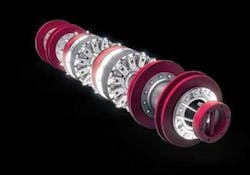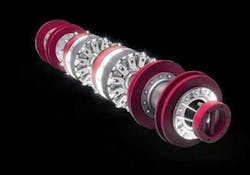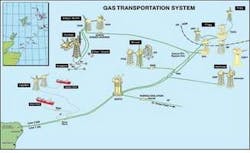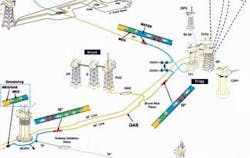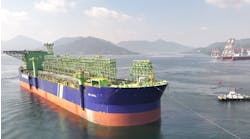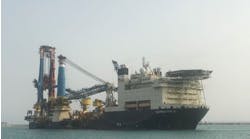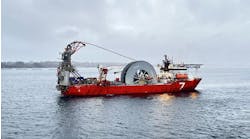Eliminate need to depressurize
Ted Moon, Technology Editor
In today’s environment of high energy prices, producers are eager to maximize output with minimal production rate disruptions. Fields with many separate wells tying into a production facility, which account for the vast majority of offshore fields around the world, present a unique challenge when it comes to maintaining production. In the event that one or more wells need to be shut in or fully decommissioned, the producer ideally wants to maintain operability through other pipelines and other wells with minimum downtime or lost production.
Use of plugging pigs to successfully isolate sections of a production system without the need to fully decommission or bleed down the entire system has garnered interest recently, and it appears that interest is growing. Unlike pigs run through pipelines to clean the pipe surface by removing scale, sludge or solid debris, or to lay a film of chemical treatment such as corrosion inhibitor, plugging pigs are designed to pass through a line to selectively plug and isolate a section.
The benefits of plugging a line versus having to depressurize it for workovers are many:
- Eliminates the need for flaring gas, in most cases
- Eliminates displacement of pipeline product
- Non-invasive procedure (no holes or potential leak areas left at the isolation location)
- Reduces or eliminates disposal of contaminated water, hydrates, or treatment chemicals, and
- Reduces time, effort and cost to decommission and recommission a pipeline.
TDW Offshore Services has experience isolating pipeline sections with minimal downtime. Formerly known as PSI, TDW Offshore provides the SmartPlug, a remote-controlled, tetherless, high-pressure isolation tool designed to isolate a section of pipeline while operating at pressure. The company says the SmartPlug is highly piggable, capable of passing through 1.5-in. diameter bends and through flexible pipe.
The SmartPlug is suitable for any pipeline medium, including gas, crude oil, distillates, treated or untreated water, glycol, or diesel. The bi-directional pigs are module-based and typically are used in a set of two independent plug modules, each of which can isolate full pipeline pressure. The same modules can be set and unset multiple times in the same pipeline to allow the isolation of multiple sections. Standard SmartPlug sizes range between 10 in. and 42 in. in diameter, although the company says other sizes are available upon request.
The SmartPlug tools are tracked and positioned in a line using a technology TDW Offshore calls the SmartTrack system. It is a proprietary control and communication system administered via a topside laptop computer. The laptop communicates with each SmartPlug by sending signals to an extremely low frequency (ELF) antenna placed near the location to be isolated. The antenna provides real time, two-way communication through the pipe wall, allowing the operator to send commands and to receive confirmation of plug conditions and pipeline pressures.
If communications fail, the pigs self-lock in the set position. As long as there is a pressure differential across the pig, it will remain locked in place. In fact, the pigs seal more tightly as system pressure increases. In addition, the SmartPlug system has a fail-safe unsetting system, which means that if all communication should fail, the plug still can be unset and retrieved.
TDW says SmartPlug technology has been used successfully on more than 90 projects worldwide and on a variety of project types that include, but are not limited to:
- Pipeline valve replacements or repairs: Use of SmartPlug tools allows topside valves to be replaced without reducing pipeline pressure or affecting the production of downstream platforms
- Tie-in of deepwater flowlines and pipelines: One SmartPlug tool on each side of a pre-installed subsea tee allows quick, safe tie-ins of future wells or pipelines
- Platform abandonment and bypass: SmartPlugs can plug both import and export lines of a platform so the lines can be cut and tied together for a subsea bypass or connected to other lines for rerouting, all without having to shut down other platforms connected to the system.
Bypass and decommissioning of Frigg field
TDW performed many North Sea bypass projects, notably on theMCP-01 and Frigg TP1 facilities in the Frigg field. The gas field, on the border between the Norwegian and British continental shelves, started production in September 1977. Gas from the field was exported via two 32-in. pipelines to a gas terminal in St. Fergus, northeast of Aberdeen on the Scottish coast. The two lines are:
- The FUKA pipeline, from theFrigg TP1 installation to St. Fergus
- The Vesterled pipeline, from theHeimdal installation to St. Fergus.
Both pipelines go through theMCP-01 gas compression facility approximately mid-way between Frigg and St. Fergus.
The Frigg field is part of a larger offshore gas system encompassing other gas producing fields including Captain, Alwyn North, Heimdal, and Bruce, among others. A program launched in 2004 to begin cessation of the Frigg field, and as part of this program, theMCP-01 and Frigg TP1 facilities were to be decommissioned and the topsides removed from the concrete structures. The two gas lines leading into St. Fergus still were required to transport gas from the remaining fields. To avoid flooding the entire 365 km pipeline, a remote plugging isolation system was developed.
The program called for TDW Offshore to perform bypass operations for the 24-in. export pipeline from Alwyn North atTP1, the 32-in. FUKA line to St. Fergus at TP1, the 32-in. pipeline at MCP-01 in 2004, and to perform bypass operations on the Vesterled line at MCP-01 in 2005. TDW Offshore Services’ SmartPlug technology was used.
The scope of work entailed precise placement of SmartPlug tools via high-pressure pumping spreads at both St. Fergus and Frigg. To succeed, pigging spreads were delivered and set up at both St. Fergus and Frigg. At St. Fergus, a Halliburton pigging spread was installed in early July 2004. At the same time, pigging spreads were installed on theTP1 platform feeding into the 32-in. FUKA line. These pigging spreads were capable of delivering water at a volume of 6 cu. m/min at 100 barg.
Following a two-week rigging and function-testing period, launching of the SmartPlug tools began. Because other fields fed into the FUKA line betweenTP1 and MCP01, it was necessary to isolate the 24-in. and 32-in. lines 3 km south of TP1, and the 32-in. FUKA line north of MCP, to prevent pipeline flooding. The pig trains typically included a SmartPlug tool, water, and MEG separated by bi-directional pigs. The MEG mitigates the formation of gas hydrates when the gas line is re-pressurized for return to service.
A tracking vessel equipped with the SmartTrack system was used to set the plug and ensure the pig train did not overrun its intended location.
Once the pipelines were isolated, lines were depressurized downstream of the SmartPlug tools and work began to connect the 24-in. export line from Alwyn, the 32-in. FUKA line fromTP1, and the subsea bypass of MCP-01. To accomplish this, 24-in. and 32-in. isolation trains were launched from Frigg on Aug. 2, 2004, with the DSV Pelican setting the SmartPlug tool three days later.
A 32-in. isolation train launched on July 29, 2004 from St. Fergus, with the vesselHighland Eagle used to set the pig train. With the pigs set, cutting, bypassing, and welding could begin.
The bypass procedure is illustrated by an examination of the Vesterled line which connectedMCP-01 to the Heimdal field. The MCP-01 platform was bypassed in 2005 using the same operation as in 2004. The pig train make-up included the SmartPlug isolation tool and bi-directional pigs for dewatering and conditioning.
AtMCP-01, the SmartPlug isolation train was pumped into position via the water pumping spread at St. Fergus North of MCP-01 to isolate gas coming from the Heimdal platform. The section between St. Fergus and the SmartPlug tool then was depressurized and the pipelines cut and connected to a new bypass line around MCP-01.
After connection was complete, the line was re-pressurized, the SmartPlug tool released, and, using a pre-installed valves system, the line was dewatered, conditioned, and recovered at St. Fergus.
All bypass and tie-in operations atMCP-01 and TP1 were complete by Aug. 19, 2005, and all pig trains, including those used to isolate the lines feeding in from the adjacent fields, were recovered subsea at TP1 and St. Fergus for the MCP-01 operation by August 26.
TDW Offshore’s use of SmartPlug tools and SmartTrack system technology allowed for safe placement and careful monitoring of all pipeline plugs during both phases of this decommissioning project. The plugging technology allowed bypass of the Frigg field andMCP-01 safely and efficiently, and also allowed gas production from the rest of the extended offshore system to resume on schedule.
